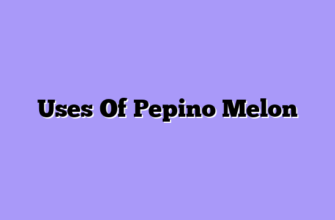Alright, folks! Michael here again, and today we’re diving into one of the most crucial skills for any fruit lover: how to pick the perfect pepino melon. Whether you’re at a farmers’ market, grocery store, or lucky enough to have these beauties growing in your backyard, knowing how to choose a ripe pepino can make all the difference in your culinary experience.
Color is Key
First things first, let’s talk about color. A ripe pepino melon, also known as melon pear or Solanum muricatum, will have a base color ranging from pale yellow to golden. Now, here’s where it gets interesting – look for those distinctive purple stripes! As the fruit ripens, these stripes become more pronounced. If you see a pepino that’s mostly green with faint stripes, it’s probably not quite ready yet.
But wait, there’s a catch! Some varieties, like the Vista we discussed earlier, have very subtle striping. In these cases, focus more on the overall color shift from green to yellow. It’s like watching a sunrise – you want that golden glow!
The Squeeze Test
Next up is the squeeze test. Now, I’m not talking about manhandling the poor fruit! A gentle press with your thumb is all you need. A ripe pepino melon will yield slightly to pressure, similar to a ripe avocado. If it’s hard as a rock, it needs more time. On the flip hand, if it feels mushy, you’ve probably missed the prime window.
Remember, pepinos continue to ripen after picking. So if you’re planning to use them in a few days, it’s okay to choose ones that are slightly firmer. They’ll be perfect by the time you’re ready to enjoy them!
The Sniff Test
Now, let’s talk about one of my favorite methods – the sniff test. A ripe pepino melon will have a sweet, fragrant aroma, especially near the stem end. If you can’t smell anything, it’s probably not ripe yet. And if it smells fermented or off, it’s best to leave that one behind.
This method works great for varieties like Miski or Toma, which are known for their intense sweetness and aroma. It’s like nature’s way of saying, “Hey, I’m ready to eat!”
Size Matters… Sometimes
When it comes to pepino melons, size can be a tricky indicator. Different varieties grow to different sizes, so what’s “normal” for an El Camino might be huge for a Miski. However, within a single variety, choose fruits that feel heavy for their size. This usually indicates juiciness and ripeness.
If you’re new to pepino melons, start with medium-sized fruits. They tend to have the best balance of flavor and texture. Think of it like Goldilocks – not too big, not too small, but just right!
Check the Skin
Last but not least, give that pepino a once-over. The skin should be smooth and free from blemishes, bruises, or soft spots. A few minor scratches are okay – these fruits aren’t runway models, after all! But anything that looks like damage or decay is a no-go.
One cool thing about pepino melons is that their skin is edible. So if you’re planning to eat them whole (which I highly recommend – it’s delicious and nutritious!), you want that skin to be in top shape.
Putting It All Together
Picking the perfect pepino melon is part science, part art, and a whole lot of fun. Remember, you’re looking for a fruit that’s:
- Yellowish in color with pronounced purple stripes (for most varieties)
- Slightly soft to the touch, but not mushy
- Fragrant, especially near the stem
- Heavy for its size
- Free from major blemishes or soft spots
And here’s a pro tip from yours truly: don’t be afraid to ask questions! If you’re at a farmers’ market or specialty store, the vendors are usually more than happy to help you pick the best fruit. We farmers love nothing more than sharing our passion for these amazing melons!
Remember, practice makes perfect. The more pepino melons you pick, the better you’ll get at identifying the perfect ones. And even if you don’t get it right every time, that’s okay! Every pepino melon, whether it’s a bush melon, tree melon, or pera melón, has its own charm. So go forth, my friends, and may your pepino picking adventures be fruitful!








